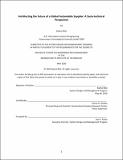| dc.contributor.advisor | Donna H. Rhodes. | |
| dc.contributor.author | Bilal, Badrul. | en_US |
| dc.contributor.other | Massachusetts Institute of Technology. Engineering and Management Program. | en_US |
| dc.contributor.other | System Design and Management Program. | en_US |
| dc.date.accessioned | 2021-10-08T16:48:07Z | |
| dc.date.available | 2021-10-08T16:48:07Z | |
| dc.date.copyright | 2020 | en_US |
| dc.date.issued | 2020 | en_US |
| dc.identifier.uri | https://hdl.handle.net/1721.1/132803 | |
| dc.description | Thesis: S.M. in Engineering and Management, Massachusetts Institute of Technology, System Design and Management Program, May, 2020 | en_US |
| dc.description | Cataloged from the official version of thesis. Page 106 blank. | en_US |
| dc.description | Includes bibliographical references (pages 100-105). | en_US |
| dc.description.abstract | Automotive industry is at the cusp of a revolutionary change. Technologies such as autonomous driving, connected vehicles, electrification of the powertrain and shared mobility (commonly referred to as ACES - autonomous, connected, electric and shared vehicles) are not only disrupting the industry but are also uncovering new business models that were non-existent a few years ago (Modi et al., 2018, p. 31). As a result of this disruption, Automotive Original Equipment Manufacturers (OEM) and their suppliers face several new challenges and are transforming themselves to adapt to these changes. Although many studies in the recent past have investigated the impact of ACES on OEMs, not many have studied the impact of this disruption on suppliers to OEMs. Automotive suppliers are an important stakeholder contributing extensively to the success of OEMs through close collaboration and partnerships. Using literature reviews and knowledge gathered from stakeholder interviews, this thesis uses the architecting innovative enterprise strategy (ARIES) framework (Nightingale & Rhodes, 2015, p. 15) to uncover the challenges involved when an automotive supplier embarks on a transformational path necessitated by the ACES revolution. The thesis proposes several architectures and evaluation criteria that could be used to determine the preferred architecture for a global automotive supplier to adopt in their quest to successfully transform and adopt a more agile culture in the face of challenges brought about by the ACES disruption. | en_US |
| dc.description.statementofresponsibility | by Badrul Bilal. | en_US |
| dc.format.extent | 106 pages | en_US |
| dc.language.iso | eng | en_US |
| dc.publisher | Massachusetts Institute of Technology | en_US |
| dc.rights | MIT theses may be protected by copyright. Please reuse MIT thesis content according to the MIT Libraries Permissions Policy, which is available through the URL provided. | en_US |
| dc.rights.uri | http://dspace.mit.edu/handle/1721.1/7582 | en_US |
| dc.subject | Engineering and Management Program. | en_US |
| dc.subject | System Design and Management Program. | en_US |
| dc.title | Architecting the future of a global automobile supplier : a socio-technical perspective | en_US |
| dc.type | Thesis | en_US |
| dc.description.degree | S.M. in Engineering and Management | en_US |
| dc.contributor.department | Massachusetts Institute of Technology. Engineering and Management Program | en_US |
| dc.identifier.oclc | 1262987003 | en_US |
| dc.description.collection | S.M.inEngineeringandManagement Massachusetts Institute of Technology, System Design and Management Program | en_US |
| dspace.imported | 2021-10-08T16:48:07Z | en_US |
| mit.thesis.degree | Master | en_US |
| mit.thesis.department | SysDes | en_US |
